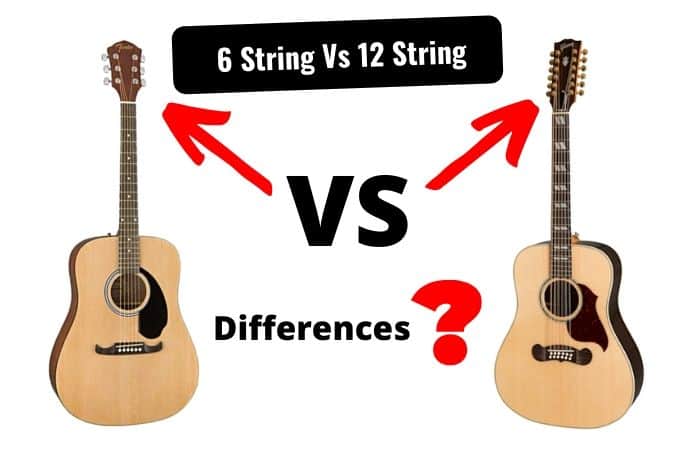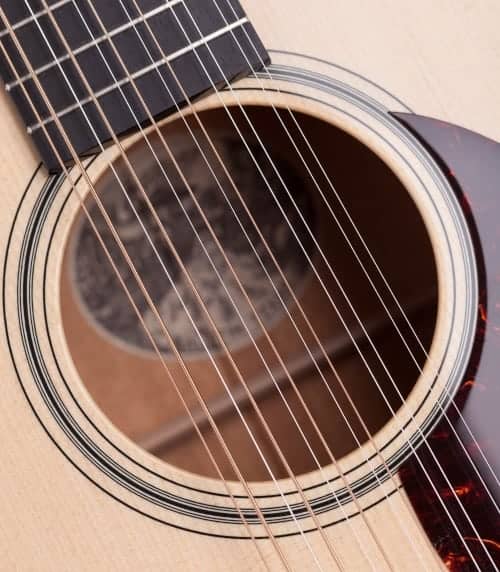
Are you interested in buying a 12 string guitar to add to your prized collection? Or perhaps just curious about the differences in sound, playability, tuning, and history between both instruments?
If so, this post answers the contrasts separating the 6 string and 12 string electric and acoustic. I will also detail whether they are ideal for beginners just starting out.
So let’s dive in… what are the main differences between both guitars…
The Short Answer
A 6 string has fewer strings, therefore, a narrower neck resulting in better playability. In comparison with a 12 string guitar, the player frets one note with two strings causing a wider neck and decreased playability. However, a 12 string has a richer and natural ‘chorus’ tone due to coupled octave strings.
Difference between 6-string and 12-String Guitars
The modern guitar as we know it now was developed in the 20th century according to the classical guitar design standard that was set in 1850 by Spanish luthier Antonio Torres Jurado. While there are different extended-range versions, 6 strings are the most common guitars.
A modern version of the 12-string guitar relies on the same instrument design and is played exactly like the usual 6 string version. The difference is you fret the coupled strings to play one singular note.

However, the main idea behind it was to have a “doubled” and “shimmering” sound of a regular acoustic or electric guitar. Also, 12-string acoustics are often louder than 6-string acoustics. Instead
Why use a 12 String Guitar?
While the first thing that might come to mind with more strings extended range, 12-string guitars cover the same spectrum as the conventional 6-string guitars.
But the main idea behind such an instrument is to create the “doubled” tone, similar to what we can see with instruments like a mandolin or the Mexican traditional instrument called “guitarra séptima.” The “shimmering” tone they produce is also comparable to the chorus effect.
Technically, each of the standard six strings has its “twin.” However, only the top two strings hit the same tones, while the bottom four are doing octaves instead of unisons.
During the 1960s, we saw the rise of 12-string electric guitars and even double-neck guitars with 6-string and 12-string versions of the instrument in one.
The most famous example is Gibson’s red EDS-1275, mostly popularized by Led Zeppelin’s Jimmy Page. One glance at this guitar instantly reminds players of the iconic song “Stairway to Heaven”.
Having more strings meant thicker necks, and in cases of electric guitars, different pickup construction. Another obvious difference is the headstock construction that’s significantly longer and somewhat wider compared to 6-strings.
String tension presented challenges for construction stability, so the necks and bodies are always reinforced. The scale length and distances between the frets are also shorter, something that also helps reduce string tension.
12-strings are usually backing instruments and have been used over the years by the likes of Jimmy Page, Michael Nesmith, Lead Belly, Carol Kaye, Leo Kotke, and many others. They were also implemented as a solo instrument, most notably by Stevie Ray Vaughan and John McLaughlin.
Pros and Cons of 12 String Guitars
Pros
Cons
- Different tone – Octaves and slight “microscopic” differences in tuning offer natural chorus effect, making it sound like two instruments are playing at once.
- Louder output in acoustic settings
- Mandolin style tone
- More strings mean more complicated restringing, as well as higher costs for new sets of strings
- While the tone is fuller, they have a narrow scope of use, mostly in folk and blues music.
- Having doubled strings requires more effort for the fretting hand. Pressing the strings will be more difficult.
- Thicker necks can be an issue, especially in lead parts.
- They’re not the best option for beginners, both in terms of playability and use.
- 12-strings are usually more expensive.
- Less versatile instrument
How to Tune Both Guitars
The most common tuning for 6-strings is E-A-D-G-B-E, while some other alternative tunings are not uncommon, including drop tunings and open tunings. Every 12-string guitar revolves around these same types of tunings, most notably the standard E-A-D-G-B-E.
But there’s a catch. The top two strings, E and B, are doubled. Meanwhile, each of the bottom four strings has a double that’s one octave higher. The full tuning goes like this: E3-E2-A3-A2-D4-D3-G4-G3-B3-B3-E4-E4. Of course, this requires special sets of strings.
This Video Demonstrates
Drop and open tunings (ex. Drop C) can also be achieved with this same principle – two higher strings are doubled, while the bottom four have their doubles and one octave higher.
Is a 12 String Harder to Play?
Generally speaking, 12-string guitars are more challenging to play. For example, the same lead section that one virtuoso can pull off on a regular 6-string will be technically more demanding on a 12-string.
This is not just due to thicker necks, but the fact that you’re supposed to press two strings at the same time, all while maintaining the grip. The string tension does not make it easier at all.
These differences can be problematic for guitar players of all skill levels. On the other hand, you’ll rarely find a 12-string guitar used in the context of a 6-string.
For the most part, any 12-string guitar is used as a backing instrument for playing chords and some additional notes. Nonetheless, playing one still requires more finger strength, even when playing simple chords in open position.
But there are still musicians who played it in the context of a lead instrument, like Jimi Hendrix or Stevie Ray Vaughan. An additional challenge in playing it as a lead instrument comes with string bending. With such a higher string tension and doubled strings, bending is very limited.
6-string or 12-string guitar for beginners?
If we’re talking about a total beginner, someone who’s never played a note in their life, it’s highly recommended that they go with a 6-string. Especially the younger players, as their hands and fingers are still not ready for this.
Beginners who have been playing regular 6-string guitars for a while will be able to adapt to 12-strings more easily.
The same goes for musicians who are experienced in other string instruments, like violins or cellos, as they’ll have an easier time adapting. Having developed callouses on fretting hand fingers helps a lot.
Another problem might come with the price of a 12-string, as they’re often more expensive on average and require more investment for string replacement. While we’re at it, restringing and tuning are quite a chore on 12-string guitars and take at least double the time compared to 6-strings.
On the other hand, if a player is more interested in folk, folk-rock, and blues music, and is really fond of the 12-string tone, then they can go down this road instead.
After all, there are no strict written rules about this, and anyone is free to choose the instrument that they feel like playing. But they should bear in mind that 12-strings can be more challenging.
Some argue that you can use a 12-string guitar with only 6 regular strings on it. However, their necks and the overall string spacings are intended for 12 strings, and this may present additional difficulties for beginners.
What’s better: 6-String or 12-string guitar?
It’s difficult to say whether one is “better” than another. For the simple reason that these two distinct types of guitars have their use in modern music.
If you want a quick answer, then we could say that 6-string guitars are “better” since they have a wider use and some of the tones could be replicated with a simple chorus pedal to an extent.
However, the organic and natural tone of 12-strings cannot be convincingly replicated with a chorus effect. Some genres or particular music pieces actually work better with this kind of tone.
In some folk-rock or blues settings, 12-string guitars are arguably a “better” solution. But like we said – they still have a significantly more narrow scope of use compared to 6-strings.
Talking about electric guitars, high-gain distortions, and power chord wouldn’t work well on 12-string guitars. They’re more suitable for clean or just slightly overdriven parts with a lot of notes that are supposed to be left “ringing.”
Related Questions
Can you play a 12 string like a 6 string?
A 12 string guitar can be played like a 6 string as you still use the same notes, chords and guitar techniques like a standard 6 string, although advanced techniques will be more difficult to play on a 12 string guitar as you have to pluck and fret two strings at once.
Should you tune down a 12 string?
12 string guitars are traditionally tuned to E standard but can be tuned down a semitone or whole tone with no issues. The reason is a 12 string guitar holds a lot of tension in the neck. Tuning a 12 string down would also make for a more flexible string making string bends easier.
